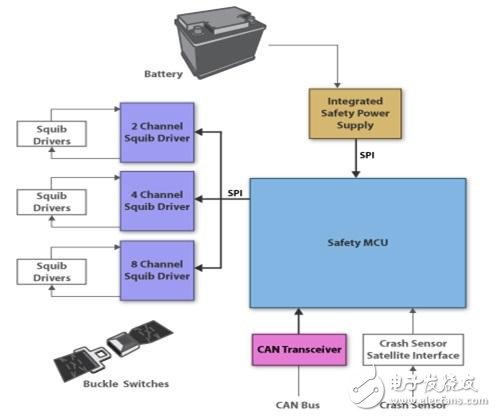From the idea of ​​the airbag concept in 1952 to the application of airbags in automobiles in 1980, in the era when the technological power was still not developed, after 28 years of long-lasting baking... the application of airbags greatly reduced the damage of accidents. The degree has improved the passive safety of the car, and now it has become the standard of the car, becoming the most important sign of a car with a safety factor.

Such an important safety device, and now the danger is always inadvertently coming. As a safety improvement, we should know the airbag, know its control unit, and know the solution...
Airbag control unit:

First, the integrated power supply
Powered by a microcontroller in safety applications such as automotive, it converts the input battery voltage to a 6V pre-regulator output
TPS65381-Q1 - Multi-Track Power Supply for Microprocessors in Safety-Critical Applications
It monitors all regulator output, battery voltage, and undervoltage and overvoltage conditions on the internal supply rail. A second bandgap reference that is independent of the main bandgap reference is used for undervoltage and overvoltage monitoring to avoid any drift within the main bandgap reference being undetected. In addition, regulator current limiting and overtemperature protection can be implemented... a wide range of applications in automotive safety systems...
Advantages and features:
1. Disable the safety path or the enable output of the external power stage when any system failure is detected.
2. Enable the drive output to disable the safe processing path or external power stage when any system failure is detected.
3. Includes a sensor supply with ground short and battery short circuit protection to power the sensor outside the electronic control unit (ECU)
Second, the security MCU
As an automotive-grade microcontroller, it carries the status of the entire system center axis
1 TMS570LS0332 -16/32-bit RISC Flash Microprocessor
A high-performance automotive-grade microcontroller family of safety systems. The security architecture includes dual-step CPUs, CPU and memory built-in self-test (BIST) logic, ECC dual flash and data SRAM, parity, and peripheral I/O loopback with integrated ARM Cortex-R4 CPU. It provides an efficient 1.66 DMIPS/MHz, can run up to 80MHz, and delivers up to 132 DMIPS performance...
Advantages and features:
1. Built-in self test CPU and on-chip RAM, voltage and clock monitoring
2. 384KB and 256KB of built-in flash memory (respectively) and 32 KB of data RAM with single bit error correction and double bit error detection
3. Flash is a 64KB data bus interface implemented for non-volatile, electrically erasable and programmable memory that operates on all 3.3 V power inputs (same level I/O power) for reading, programming and erasing operating
2 TMS470MF03107- 16/32-bit RISC Flash Microprocessor
Automotive Grade 16/32-bit Reduced Instruction Set Computer (RISC) microcontroller family. High performance with the highly efficient Cortex®-M3 16/32-bit RISC central processing unit (CPU), resulting in high instruction throughput and better code efficiency...
Third, the squib driver
The blaster driver is controlled by the MCU via SPI (2 channels, 4 channels, 8 channels)
2-channel squib driver
TPIC71002-Q1- Automotive Two-Channel Bursting Driver
A dual-channel squib driver for airbag deployment in automotive applications. Each channel includes high-side and low-side switches, and independent control logic is provided to prevent inadvertent deployment. Both the high side and low side switches support internal current limit and over temperature protection. To avoid excessive power consumption, the maximum operating ON time per channel is limited by the programmable ignition timer. In addition, the current limit register can be used to program the maximum current through the switch during deployment... Absolutely applied in the airbag squib driver...
Advantages and features:
1. Two logic inputs provide independent safety logic for enabling/disabling deployment, two independent thermally protected high-side drivers, and can deploy or diagnose current levels to each squib load source
2. Each deployment loop uses a register to set a single ignition current timer limit, and an ignition current timer monitors the ignition current for each deployment loop deployment time.
3. Proportional squib resistance measurement can be achieved when the external pin is connected to the microprocessor ADC power supply
4-channel squib driver
TPIC71004-Q1-Automotive four-channel squib driver
A 4-channel squib driver for automotive application airbag deployment with IC registers for 4-channel configuration, control and status monitoring. To avoid inadvertent deployment, the high and low side switches can only be turned on when the appropriate configuration is ordered and multiple inputs to the controller logic are deployed to a standard level. This register is programmed using the serial communication interface.
Advantages and features:
1. To avoid excessive power consumption, the maximum on-time per channel is limited by the programmable ignition timer.
2. Extending the deployment time activates the overtemperature protection circuit and terminates the deployment. If a short to ground condition occurs during deployment, this will initiate a thermal shutdown protection mechanism to protect the device.
3. The squib pin uses an external clamping device, which does not require protection of the ASIC for the substrate insertion effect caused by dynamic short-circuit grounding during deployment.
3 eight-channel squib driver
TPIC71008-Q1 - Automotive Octopus Driver
An 8-channel squib driver for automotive airbag deployment. The device's diagnostics monitor the deployed pin voltage, which enables high-side switch testing, low-side switch testing, squib resistance measurement, squib battery or ground leakage measurement, or leakage measurement of any squib channel, extending deployment time to activate Over temperature protection circuit and terminate deployment...
Advantages and features:
1.8 independent thermally protected high side drivers that provide deployment or diagnostic current levels for each squib load
2.8 independent avalanche voltage and thermal protection low side drivers that can be deployed or diagnosed from each squib load
3. The damping device used for the squib pin does not need to protect the ASIC from the effects of substrate insertion due to dynamic short circuit or grounding.
Fourth, CAN transceiver
SN65HVDA540-Q1- Automotive 5V CAN Transceiver with I/O Level Translation and Power Optimization
The device is designed and qualified for automotive applications and meets or exceeds ISO11898 high-speed CAN, providing CAN transceiver functionality: differential transmit capability, bus and differential receive capability, and data rates up to 1 Mbps per second. It also includes a number of protection features that provide the richness of equipment and CAN networks...
Advantages and features:
1.ESD protects bus pins up to ±12 kV (human body model)
2. High electromagnetic compatibility (EMC) protection, undervoltage protection VIO and VCC and BUS fault protection -27 V ~40 V
3. TXD dominant state timeout, RXD wakeup request locks CAN bus lock, when no power high bus input impedance
Five, the impact sensor
The collision sensor detects the deceleration or inertial force of the car when the collision occurs, and sends the signal to the MCU. The collision sensors currently prevalent in the market mainly include the following:
â—Rolling ball collision sensor, Nissan and Mazda in Japan use this sensor
â—Roller type collision sensor, Japan's Toyota, Honda, Mitsubishi use this sensor
â— Mercury switch collision sensor
â—Resistive strain gauge type collision sensor
â—Piezoelectric impact sensor
With the development of technology and people's attention to the safety of automobiles, the airbag technology in automobile safety technology has also developed rapidly. Intelligent and multi-airbags are the inevitable trend of the development of the overall airbag system in the future.
New technologies can better identify passenger types and take different protective measures. The system uses weight, infrared, ultrasonic and other sensors to determine the distance between the passenger and the instrument panel, weight, height and other factors, and then judge whether to burst the airbag during the collision, use the first-class ignition or multi-stage ignition, how big the point explosion force, and The seat belt forms an overall control. Through the sensor, the airbag system can also determine the form of collision that the vehicle is currently experiencing, whether it is a frontal collision or an angular collision, a side collision or a tumbling motion of the whole vehicle, so as to drive the airbags at different positions of the vehicle body to form the best protection for the passengers...
ACCURATE and RELIABLE: This oximeter can measure and monitor heart rate, SpO2 and pulse intensity with high accuracy. Displays waveform (plethysmograph) and digital readings, as well as pulse bar graphs, to visually indicate any irregularities or abnormalities, such as weak heartbeat.
EASY TO USE: Insert finger into rubber of the pulse oximeter and press "on". Intelligent tool for patients, exercise recovery, elderly, hikers, climbers (monitor the oxygenation rate of cells, for overall health). Essential to take reading without moving the body or hand to obtain accurate result.
LIGHT AND PORTABLE: Monitor is very light, small in size, low in power consumption and easy to carry with detachable lanyard; so, you can measure oxygen saturation anywhere. Auto power off s seconds after removing finger saves battery life
Medical Diagnostic Pulse Oximeter
Pulse Oximeter Sensor,Best Pulse Oximeter,Medical Diagnostic Pulse Oximeter,Blood Oxygen Saturation Monitor
Axiswell Technology Co., Ltd , https://www.medhealthycare.com
